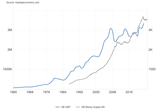Search Results
7/9/2025, 12:02:31 PM
>>509907602
There are 2 types of fiat currency:
1. Physical cash and coins printed, minted or coined by the central banks (or for them by private businesses under exclusivity contracts with the central banks).
2. Money of account. This is fictional cash and coins which don't exist physically and are just promises to pay cash or coins, in the same nominal amount, to the holder, on demand. They exist on the ledgers of the banking system.
Banks have been granted the right to "legally" deceive the entirety of society that the second type of fiat currency is the same as the first or that it doesn't exist, with the implication being that the second type of fiat currency is actually the first type when it really isn't. The proof that these two are not the same type of fiat currency, and also the proof that there is *A LOT* more of the second type in existence than the first, is that banks can run out of the first type of fiat currency to honour "withdrawal" requests against the second type, by depositors who think they're the same thing, and to avoid that happening, there are laws on the books in every country to force private individuals and businesses to store their physical fiat currency notes and coins, above a meagre amount, in banks and thus only use the second type of fiat currency for their larger transactions. In addition to this, convenience and online purchases ensure that most people prefer the second type of fiat currency.
While only central banks control the creation and issuance into circulation in the economy of the first type of fiat currency, any non-central bank anywhere can issue more of the second type of fiat currency into circulation. They do this by pretending to "lend" the first type of fiat currency to willing borrowers. But in actual fact, they just create more of the second type of fiat currency when they approve the "loan" (which is actually credit and not a loan) and issue it to the borrower. Or a credit card holder pays for something with it.
There are 2 types of fiat currency:
1. Physical cash and coins printed, minted or coined by the central banks (or for them by private businesses under exclusivity contracts with the central banks).
2. Money of account. This is fictional cash and coins which don't exist physically and are just promises to pay cash or coins, in the same nominal amount, to the holder, on demand. They exist on the ledgers of the banking system.
Banks have been granted the right to "legally" deceive the entirety of society that the second type of fiat currency is the same as the first or that it doesn't exist, with the implication being that the second type of fiat currency is actually the first type when it really isn't. The proof that these two are not the same type of fiat currency, and also the proof that there is *A LOT* more of the second type in existence than the first, is that banks can run out of the first type of fiat currency to honour "withdrawal" requests against the second type, by depositors who think they're the same thing, and to avoid that happening, there are laws on the books in every country to force private individuals and businesses to store their physical fiat currency notes and coins, above a meagre amount, in banks and thus only use the second type of fiat currency for their larger transactions. In addition to this, convenience and online purchases ensure that most people prefer the second type of fiat currency.
While only central banks control the creation and issuance into circulation in the economy of the first type of fiat currency, any non-central bank anywhere can issue more of the second type of fiat currency into circulation. They do this by pretending to "lend" the first type of fiat currency to willing borrowers. But in actual fact, they just create more of the second type of fiat currency when they approve the "loan" (which is actually credit and not a loan) and issue it to the borrower. Or a credit card holder pays for something with it.
6/28/2025, 1:01:09 AM
>>508906137
Based post.
Based post.
Page 1
